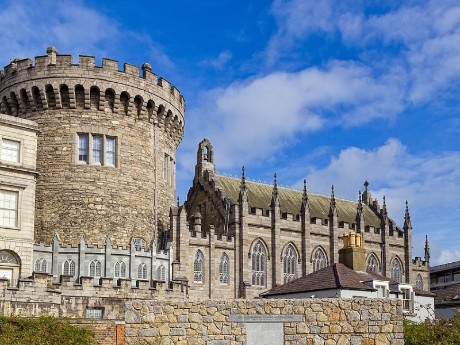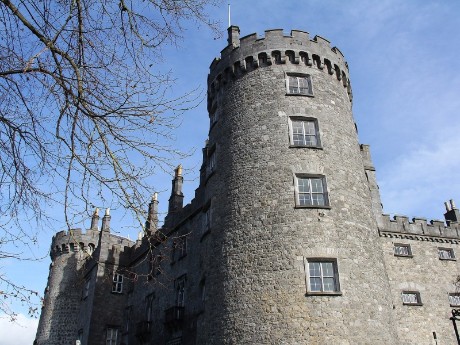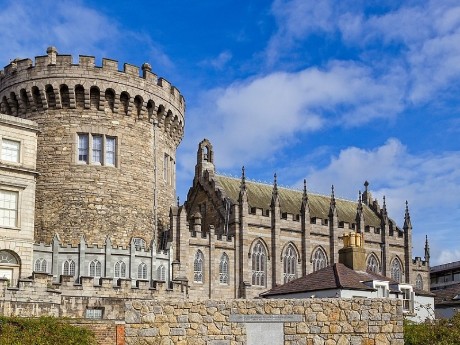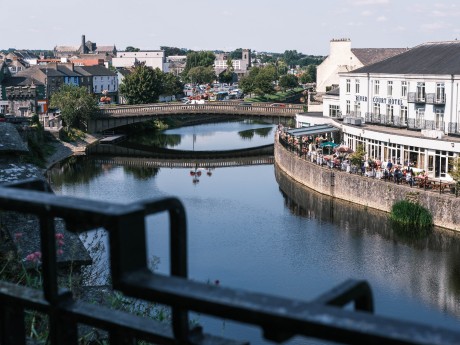Ireland: Dublin & Kilkenny
Embark on a journey to discover the enchantment of Ireland. In Dublin, a bustling cultural center, taste Irish beer and learn about the brewing process at the Guinness Storehouse. Immerse yourself in medieval art and literature at Trinity College's vast library and view the Book of Kells. Dive into Ireland's past at the Kilmainham Gaol Museum, showcasing the political and social history of Ireland through a tour of the notorious prison.
Read more
Embark on a journey to discover the enchantment of Ireland. In Dublin, a bustling cultural center, taste Irish beer and learn about the brewing process at the Guinness Storehouse. Immerse yourself in medieval art and literature at Trinity College's vast library and view the Book of Kells. Dive into Ireland's past at the Kilmainham Gaol Museum, showcasing the political and social history of Ireland through a tour of the notorious prison. Art lovers can appreciate the National Gallery of Ireland or the Irish Museum of Modern Art. From Dublin, head to Kilkenny, a city renowned for its medieval architecture and rich cultural heritage. Explore Kilkenny Castle and its gardens with a breathtaking view of the city and countryside. For a unique cultural experience, visit the Smithwick's Brewery which showcases the history of the famed Irish ale and offers a chance to sample some of the local brews. Experience Kilkenny's vibrant arts and music scene with the Kilkenny Arts Festival and Cat Laughs Comedy Festival. Experience the unique blend of history, culture, and hospitality on this trip. Waterviews strives to offer accommodation options within walking distance of water and/or in an area of touristic interest. Our prices include taxes (but excludes local tourist taxes). Customize your trip to your personal preferences with optional activities (hit the “Add Activities’’) or change hotels, etc. Contact us for customization at no extra cost at: Service@waterviewstravel.com
Destinations
- Dublin
- Kilkenny
- Dublin
Itinerary
Dublin

The vibrant, world-renowned capital of Ireland is an essential stop in any visit to the country. Dublin is a dynamic hub buzzing with life, and offers something for every traveller with its mixture of historical buildings and modern architecture within a compact city centre. Spend the day visiting museums and learning about Ireland’s literary legends, before sampling some of the famous Irish charm in one of Dublin’s many pubs and enjoying some live music while chatting to friendly and welcoming locals over a Guinness or two.
Read more
The vibrant, world-renowned capital of Ireland is an essential stop in any visit to the country. Dublin is a dynamic hub buzzing with life, and offers something for every traveller with its mixture of historical buildings and modern architecture within a compact city centre. Spend the day visiting museums and learning about Ireland’s literary legends, before sampling some of the famous Irish charm in one of Dublin’s many pubs and enjoying some live music while chatting to friendly and welcoming locals over a Guinness or two.
Additional Information
History
Founded in 841, Dublin was originally settled by Vikings among a population of Celtic tribes. In the 9th century the Danes captured Dublin and had control until 1171 when they were expelled by King Henry II of England. By the 14th century the king of England controlled Dublin and the surrounding area referred to as “the Pale”.
When the English Civil War ended in 1649, Oliver Cromwell took over. Dublin experienced huge growth and development in the 17th century because many Protestant refugees from Europe came to Dublin. By the 17th century Dublin was the second largest city in the British Isles, only behind London, and a period when great Georgian style buildings were constructed that still stand today. Georgian style architecture was popular from 1720 to 1840 during the times when George I, George II, George III, and George IV of England were ruling.
In 1800, the Act of Union between England and Ireland abolished the Irish Parliament. From this point on, the Irish worked to gain their independence from England, which they finally won in 1922. The Easter rising in 1916 and the War of Independence greatly helped Ireland win their freedom.
A failed attempt to take over the several important buildings, among them the General Post Office on O'Connell Street, led to the arrest of hundreds and execution of 15, now considered martyrs for the cause. Many believe that this event helped gain sympathy for the fight for independence from Britain.
Orientation
Dublin is divided by the River Liffey. On the north side of the Liffey is O'Connell Street — the main thoroughfare, which is intersected by numerous shopping streets, including Henry Street and Mary Street, the busiest shopping district in the city. On the south side are St. Stephen's Green and Grafton Street, the second busiest and most upmarket shopping area, Trinity College, Christ Church and St. Patrick's Cathedrals, the main branch of the National Museum, and many other attractions.
Dublin postal districts range from Dublin 1 to Dublin 24. As a rule, odd numbers are given to areas north of the River Liffey, while even numbers are given to areas south of the river (exceptions are Dublin 8 and 20 which span both sides of Liffey). Usually, the lower the district number, the closer to the city centre.
Although some of Dublin's finest Georgian architecture was demolished in the mid-20th century, a remarkable amount remains. At one point these buildings were considered a reminder of the past British imperialism and many were demolished without regard to their beauty and architectural significance and replaced with modernist or pastiche office blocks, parts of St. Stephen's Green (Dublin 2) being a prime example. Thankfully, attitudes have changed significantly, and Dubliners are now rightly proud of their impressive buildings from all eras.
© Sourced from Wikivoyage
Kilkenny

Regarded as the medieval capital of Ireland, Kilkenny mixes rich cultural heritage with exciting and vibrant nightlife. This small city remains one of the most popular destinations in Ireland, due to its picturesque setting along the banks of the River Nore, between the enchanting Kilkenny Castle and the famous St Canice’s Cathedral. Wander through the narrow lanes, making sure to visit the historic churches and fine cafes and pubs on its ‘Medieval Mile’.
Read more
Regarded as the medieval capital of Ireland, Kilkenny mixes rich cultural heritage with exciting and vibrant nightlife. This small city remains one of the most popular destinations in Ireland, due to its picturesque setting along the banks of the River Nore, between the enchanting Kilkenny Castle and the famous St Canice’s Cathedral. Wander through the narrow lanes, making sure to visit the historic churches and fine cafes and pubs on its ‘Medieval Mile’.
Additional Information
Kilkenny (Irish: Cill Chainnigh) is one of the most popular tourist destinations in Ireland, and is a weekend getaway for many Irish. Well regarded for its vibrant nightlife, it has become increasingly popular in recent years. The city is famous for its many mediaeval buildings and is referred to as the Marble City after the black polished limestone ['marble'] that was quarried around the city. The concept of a "Medieval Mile" has been instigated which endeavours to take in the majority of the city's iconic sights bookended by the Castle and St Canice's Cathedral respectively. Along the route, plaques have been put in place giving some historic background to the landmarks.
Despite its small population, it holds ancient city status due to having a cathedral and an old royal charter dating from 1609. The locals do not take kindly to the city being referred to as a "town". In the mid 1960s various arts and craft enterprises were set up in what was the stables for Kilkenny Castle. These still exist in various forms and in the county – particularly in Thomastown.
The city plays host to several festivals that bring large crowds from all over Ireland. St. Patrick's Day weekend sees TradFest which brings renowned Irish trad musicians to the city and offers a music trail for enthusiasts, On the May bank holiday weekend, the Rhythm and Roots music festival takes place in pubs and other venues around the city. On the June bank holiday weekend, the Cat Laughs comedy festival takes place. In August, the Kilkenny Arts Festival, second only to its Galway equivalent, takes place. Venues for this last festival include the Castle and St Canice's Cathedral. Savour Kilkenny and the Subtitles festival are scheduled later in the year. The city centre is bookended by its two primary tourist attractions: St Canice's Cathedral to the north in Irishtown and Kilkenny Castle at the opposite end located on the Parade. The city has the greatest concentration of medieval churches in the country. On the occasion of the State purchasing St Mary's Hall, Ireland's paper of record, the Irish Times, stated that "St Mary's Hall in located halfway along the trail of the most significant medieval urban landscape in Ireland". All year round the coaches which line the Parade underline the popularity of Kilkenny as a tourist destination.
The lower end of the Parade, from the Castle to the traffic lights at the beginning of High Street, has recently been redesigned. It has created a pleasant pedestrian zone and also permits a nice vista of the Castle from High Street. It is the location of the only public toilets in the city. This new crude structure has had its appearance softened somewhat by the placing of tourist information boards across the front. These are well worth reading and will aid your enjoyment of the historic city. On Thursdays, a farmers market is held on the Parade. The tourist office, open all year round, is in Shee Alms House, on Rose Inn Street, five minutes walk from the Castle.
As a rule Kilkenny is a white collar city with one notable exception: Smithwicks, which was still brewed until 2013 at St Francis Brewery on Parliament Street. Glanbia, formerly Avonmore, a giant in food production, has its administration headquarters on the edge of the city having being founded twelve miles away in Ballyraggett, Co. Kilkenny. The main venue for performing arts is the art deco Watergate Theatre located between Parliament Street and Irishtown. The predominant sport in Kilkenny is hurling. Hurling is one of two codes in the Gaelic Athletic Association (GAA). Hurling is played with a wooden stick called a hurley. Using the hurley you hit a cork ball called a slíotar. Kilkenny as a county has won the most All-Ireland titles in the country. The local GAA stadium is Nowlan Park 10 minutes walk from the train station. The nickname for the team is the Cats. If Kilkenny are playing in the All-Ireland Final on the first Sunday of September, the city and county is decked out in the team colours of black and amber. It will be the talk of the town if they reach the Final. The Final is played in Croke Park, Dublin.
As a matter of curiosity, Kilkenny maybe the only place in Ireland with a street called The Parade. Only in Kilkenny and Dublin is there a Parliament Street.
Sightseeing, partying or a spot of shopping in Kilkenny's array of excellent shops, this city is certain to have it all for everyone.
History
Kilkenny has a long and interesting history. The city's origins pre-date the medieval landmarks existing today. Saint Canice founded a monastic settlement in Kilkenny in the sixth century. The sole remaining landmark from this settlement is the round tower beside St Canice's Cathedral. Strongbow, the famous Norman Conqueror, then built a fortress in the City, Kilkenny Castle, and soon the construction of the walled city began.
It wasn't until the 17th century that Kilkenny really entered its golden age. The parliament known as the Confederation of Kilkenny was founded in 1641. This, also known as Confederate Ireland, refers to the period of Irish self-government between the Rebellion of 1641 and the Cromwellian conquest of Ireland in 1649. One of the Parliament's main objectives was to unite resistance against English persecution of Irish Catholics. With the emergence of this parliament, Kilkenny entered a period of unparalleled success. Over time, however, the influence of the Confederation of Kilkenny diminished. Oliver Cromwell's arrival in Kilkenny heralded the dissolution of the parliament, and the city never quite regained the prosperity it had been celebrated for.
© Sourced from Wikivoyage
Dublin

The vibrant, world-renowned capital of Ireland is an essential stop in any visit to the country. Dublin is a dynamic hub buzzing with life, and offers something for every traveller with its mixture of historical buildings and modern architecture within a compact city centre. Spend the day visiting museums and learning about Ireland’s literary legends, before sampling some of the famous Irish charm in one of Dublin’s many pubs and enjoying some live music while chatting to friendly and welcoming locals over a Guinness or two.
Read more
The vibrant, world-renowned capital of Ireland is an essential stop in any visit to the country. Dublin is a dynamic hub buzzing with life, and offers something for every traveller with its mixture of historical buildings and modern architecture within a compact city centre. Spend the day visiting museums and learning about Ireland’s literary legends, before sampling some of the famous Irish charm in one of Dublin’s many pubs and enjoying some live music while chatting to friendly and welcoming locals over a Guinness or two.
Additional Information
History
Founded in 841, Dublin was originally settled by Vikings among a population of Celtic tribes. In the 9th century the Danes captured Dublin and had control until 1171 when they were expelled by King Henry II of England. By the 14th century the king of England controlled Dublin and the surrounding area referred to as “the Pale”.
When the English Civil War ended in 1649, Oliver Cromwell took over. Dublin experienced huge growth and development in the 17th century because many Protestant refugees from Europe came to Dublin. By the 17th century Dublin was the second largest city in the British Isles, only behind London, and a period when great Georgian style buildings were constructed that still stand today. Georgian style architecture was popular from 1720 to 1840 during the times when George I, George II, George III, and George IV of England were ruling.
In 1800, the Act of Union between England and Ireland abolished the Irish Parliament. From this point on, the Irish worked to gain their independence from England, which they finally won in 1922. The Easter rising in 1916 and the War of Independence greatly helped Ireland win their freedom.
A failed attempt to take over the several important buildings, among them the General Post Office on O'Connell Street, led to the arrest of hundreds and execution of 15, now considered martyrs for the cause. Many believe that this event helped gain sympathy for the fight for independence from Britain.
Orientation
Dublin is divided by the River Liffey. On the north side of the Liffey is O'Connell Street — the main thoroughfare, which is intersected by numerous shopping streets, including Henry Street and Mary Street, the busiest shopping district in the city. On the south side are St. Stephen's Green and Grafton Street, the second busiest and most upmarket shopping area, Trinity College, Christ Church and St. Patrick's Cathedrals, the main branch of the National Museum, and many other attractions.
Dublin postal districts range from Dublin 1 to Dublin 24. As a rule, odd numbers are given to areas north of the River Liffey, while even numbers are given to areas south of the river (exceptions are Dublin 8 and 20 which span both sides of Liffey). Usually, the lower the district number, the closer to the city centre.
Although some of Dublin's finest Georgian architecture was demolished in the mid-20th century, a remarkable amount remains. At one point these buildings were considered a reminder of the past British imperialism and many were demolished without regard to their beauty and architectural significance and replaced with modernist or pastiche office blocks, parts of St. Stephen's Green (Dublin 2) being a prime example. Thankfully, attitudes have changed significantly, and Dubliners are now rightly proud of their impressive buildings from all eras.
© Sourced from Wikivoyage





